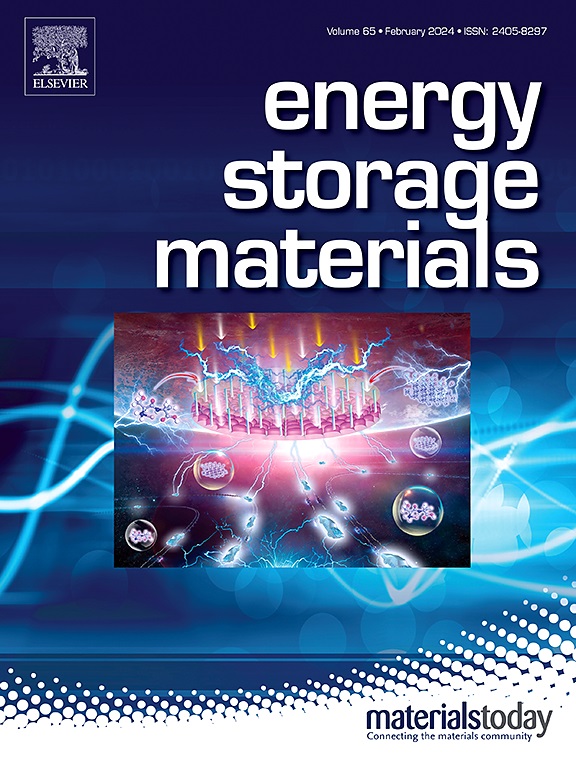用于钠金属电池的阴离子锚定和抗降解纤维素分离器
IF 20.2
1区 材料科学
Q1 CHEMISTRY, PHYSICAL
引用次数: 0
摘要
可再生纤维素生物聚合物由于其调节离子运输和钠沉积的能力,已成为钠金属电池可持续和高效的隔膜材料。在这项研究中,我们通过修饰Zr-O络合物涂层来设计纳米纤维素分离器,该涂层消除了传统纳米纤维素中固有的强氢键相互作用,赋予分离器抗降解和阴离子锚定性能。Zr-O配合物不仅保留了纳米纤维网络,提高了纳米纤维素的电化学稳定性,而且扩大和稳定了离子传输通道。更重要的是,该Zr-O络合物涂层将主要吸附在羧基上的Na+离子转变为优先固定ClO4-阴离子,导致Na+转移数高达0.76。同时,实验和计算结果均表明,Zr-O配合物的铁电特性促进了ClO4-阴离子的还原,有利于形成富集NaCl/ naf的固体电解质界面相。这些改进显著提高了循环稳定性,Na||Na细胞在0.25 mA cm-2/0.25 mAh cm-2下运行1100小时,比传统的纤维素分离器长约2.6倍。本研究通过天然生物聚合物的创新工程,为可持续、高性能的可充电钠金属电池的发展提供了新的见解。本文章由计算机程序翻译,如有差异,请以英文原文为准。


Enabling anion-anchoring and anti-degradation cellulose separators for sodium metal batteries
Renewable cellulose biopolymers have emerged as sustainable and efficient separator materials for sodium metal batteries, owing to their capacity to regulate ion transport and sodium deposition. In this study, we engineer nanocellulose separators by introducing a Zr-O complex coating layer, which negates the intrinsically strong hydrogen bond interactions in conventional nanocellulose, endowing the separator with anti-degradation and anion-anchoring properties. The Zr-O complex not only preserves the nanofibrous network and improves the electrochemical stability of nanocellulose but also expands and stabilizes ion transport channels. More importantly, this Zr-O complex coating transforms the predominantly Na+ ions adsorption on carboxyl groups into preferentially ClO4- anions immobilization, leading to a high Na+ transference number of 0.76. Meanwhile, both experimental and calculation results demonstrate that the intrinsic ferroelectric properties of the Zr-O complex promote the reduction of ClO4- anions, and facilitate the formation of a NaCl/NaF-enriched solid electrolyte interphase. These enhancements significantly improved cycle stability, with the Na||Na cells operating over 1100 h at 0.25 mA cm-2/0.25 mAh cm-2, about 2.6 times longer than traditional cellulose separators. This research offers new insights into the development of sustainable, and high-performance rechargeable sodium metal batteries through the innovative engineering of natural biopolymers.
求助全文
通过发布文献求助,成功后即可免费获取论文全文。
去求助
来源期刊

Energy Storage Materials
Materials Science-General Materials Science
CiteScore
33.00
自引率
5.90%
发文量
652
审稿时长
27 days
期刊介绍:
Energy Storage Materials is a global interdisciplinary journal dedicated to sharing scientific and technological advancements in materials and devices for advanced energy storage and related energy conversion, such as in metal-O2 batteries. The journal features comprehensive research articles, including full papers and short communications, as well as authoritative feature articles and reviews by leading experts in the field.
Energy Storage Materials covers a wide range of topics, including the synthesis, fabrication, structure, properties, performance, and technological applications of energy storage materials. Additionally, the journal explores strategies, policies, and developments in the field of energy storage materials and devices for sustainable energy.
Published papers are selected based on their scientific and technological significance, their ability to provide valuable new knowledge, and their relevance to the international research community.
 求助内容:
求助内容: 应助结果提醒方式:
应助结果提醒方式:


